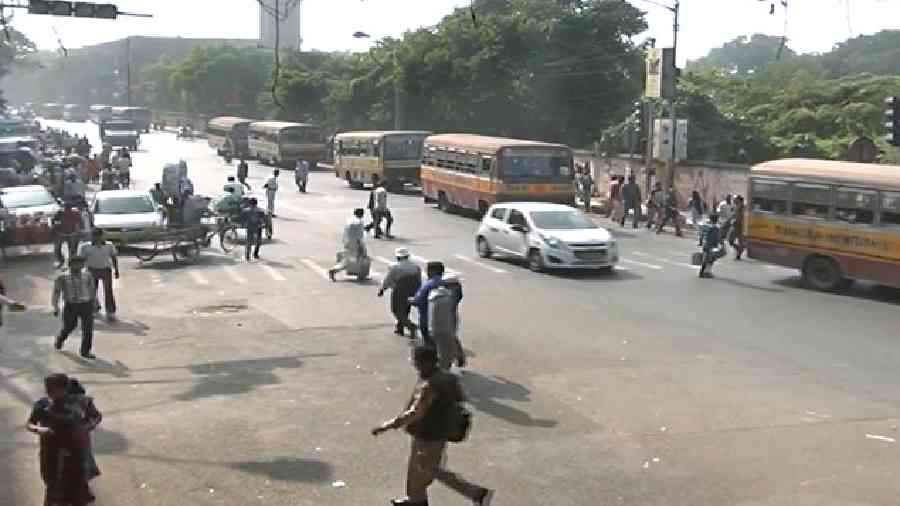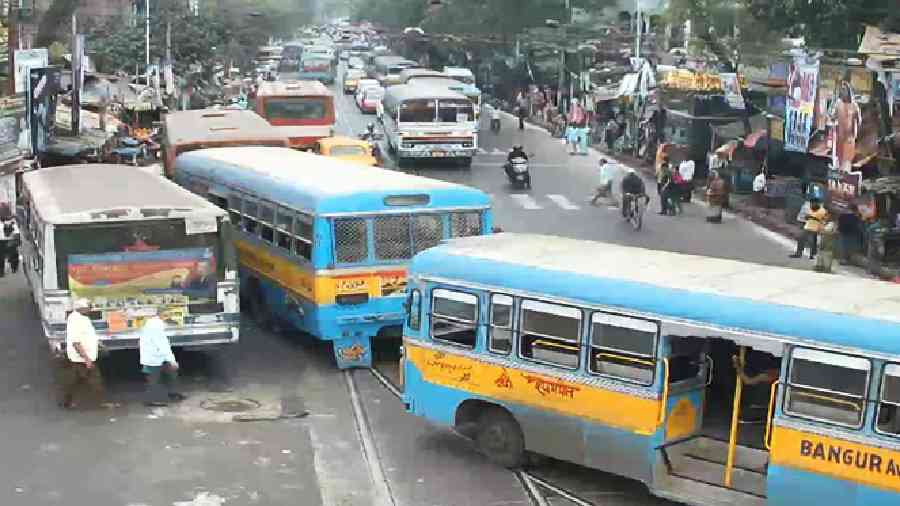Inaccessible zebra crossings, on-street parking, and undesignated bus stops exacerbate Kolkata pedestrians’ difficulties in crossing roads at traffic intersections in the city, a study probing challenges to pedestrians has found.
The study by transportation researchers at the Indian Institute of Technology, Kharagpur, and the World Bank, Washington DC, has identified multiple factors that either increase or decrease the crossing difficulty for pedestrians.

Sealdah Railway Station Road-Beleghata Road crossing: Absence of accessible zebra crossing, Encroachment of footpath, Lack of commuter facilities at the bus stop, Absence of pedestrian signal
The researchers have also correlated pedestrian crossing difficulty with pedestrian accident statistics from Kolkata police over a six-year period (2011-2016) to pinpoint some high-risk locations — Strand Road-Nimtala Ghat intersection, Strand Road-Woodmount Street crossing and Shyambazar crossing, among others.
“Everybody knows high traffic volume and large road width make crossings difficult, but this study has also identified some not-so-obvious factors,” said Dipanjan Mukherjee, a former research scholar at IIT Kharagpur and the lead author of the study.
The study has confirmed that high average traffic volume has the biggest impact on pedestrian crossing difficulty. But it has also found that inaccessible pedestrian crosswalks — zebra crossings — encroachment of footpaths and on-street parking add to the difficulty.

Strand Road-Woodmount Street intersection: Absence of adequate sidewalk facility, Absence of designated bus stop, Absence of accessible pedestrian zebra crossing, Absence of pedestrian signal
On-street parking and encroachment of footpaths hinder free movement of pedestrians, obstruct road visibility, and can render zebra crossings inaccessible to pedestrians, Mukherjee said.
“Drivers and pedestrians need to maintain enhanced alertness levels at such sites.”
Mukherjee and his research superviser Sudeshna Mitra, now at the Global Road Safety Facility at the World Bank, analysed responses to questionnaire about crossing difficulty from 6,800 pedestrians at 55 signalised and 55 unsignalised intersections along nine road corridors in the city.

MG Road-Burrabazar Road intersection: Discontinuous pedestrian-marked crosswalk, Encroachment of footpath, Commercial hub, Pedestrian carrying overhead loads, High pedestrian-vehicle interaction
Each respondent was asked to grade the crossing difficulty on a scale of one to six.
They also studied nearly 120,000 video images of pedestrian movements at the 110 intersections. Over the study period, the Strand Road-Nimtala Ghat intersection had recorded 13 pedestrian fatalities, compared with four fatalities at the Strand Road-Woodmount Street intersection, and three at the Shyambazar crossing.

Jagannath Ghat: Absence of pedestrian zebra crossing, Absence of designated bus stop, Lack of signal control, Poor visibility, Absence of footpath
Other sites covered included MG Road-Kalabangan Basti (two fatalities, Bengal Chemical crossing (one fatality), and Strand Road-MG Road crossing (four fatalities). A 1 per cent increase in area encroached on footpaths increased the crossing difficulty by 22 per cent.
The presence of an educational institution, a hospital or a shopping mall — or similar sites expected to draw large numbers of people — increased the crossing difficulty by 15 per cent.

Shyambazar crossing: High pedestrian-vehicle interaction, Absence of the pedestrian signal, Absence of designated bus stop, Inaccessible zebra crossing
The presence of on-street parking raised crossing difficulty by 13 per cent. The study has been published in the research journal of the International Association of Traffic and Safety Sciences, IATSS Research.
Signals at intersections had the biggest impact on reducing crossing difficulty. The mere presence of police personnel at the intersections also lowered difficulty, an observation that the researchers say could be explained by attempts by the police to regulate traffic, allowing the public to pass.
The researchers have recommended grade-separated walkways (either subways or overbridges), exclusive pedestrian-only phases at signals, crossing facilities at bus stops, and pedestrian crosswalks connected to footpaths at encroachment-free locations among steps to reduce crossing difficulty.
